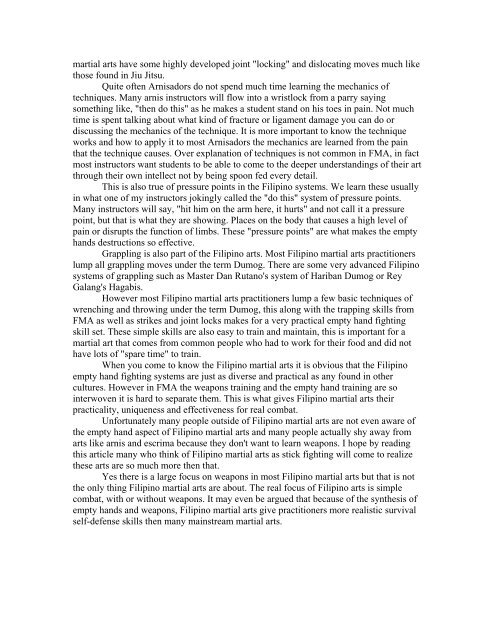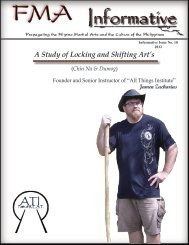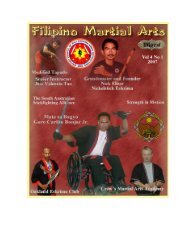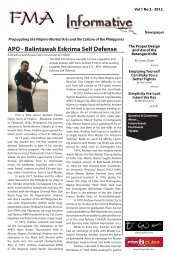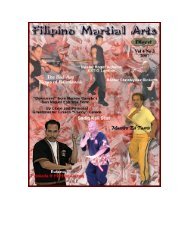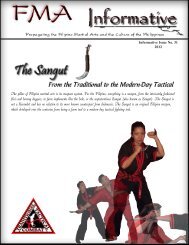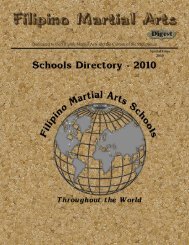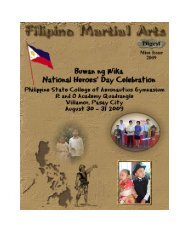Tournaments - FMA Informative
Tournaments - FMA Informative
Tournaments - FMA Informative
You also want an ePaper? Increase the reach of your titles
YUMPU automatically turns print PDFs into web optimized ePapers that Google loves.
martial arts have some highly developed joint "locking" and dislocating moves much like<br />
those found in Jiu Jitsu.<br />
Quite often Arnisadors do not spend much time learning the mechanics of<br />
techniques. Many arnis instructors will flow into a wristlock from a parry saying<br />
something like, "then do this" as he makes a student stand on his toes in pain. Not much<br />
time is spent talking about what kind of fracture or ligament damage you can do or<br />
discussing the mechanics of the technique. It is more important to know the technique<br />
works and how to apply it to most Arnisadors the mechanics are learned from the pain<br />
that the technique causes. Over explanation of techniques is not common in <strong>FMA</strong>, in fact<br />
most instructors want students to be able to come to the deeper understandings of their art<br />
through their own intellect not by being spoon fed every detail.<br />
This is also true of pressure points in the Filipino systems. We learn these usually<br />
in what one of my instructors jokingly called the "do this" system of pressure points.<br />
Many instructors will say, "hit him on the arm here, it hurts" and not call it a pressure<br />
point, but that is what they are showing. Places on the body that causes a high level of<br />
pain or disrupts the function of limbs. These "pressure points" are what makes the empty<br />
hands destructions so effective.<br />
Grappling is also part of the Filipino arts. Most Filipino martial arts practitioners<br />
lump all grappling moves under the term Dumog. There are some very advanced Filipino<br />
systems of grappling such as Master Dan Rutano's system of Hariban Dumog or Rey<br />
Galang's Hagabis.<br />
However most Filipino martial arts practitioners lump a few basic techniques of<br />
wrenching and throwing under the term Dumog, this along with the trapping skills from<br />
<strong>FMA</strong> as well as strikes and joint locks makes for a very practical empty hand fighting<br />
skill set. These simple skills are also easy to train and maintain, this is important for a<br />
martial art that comes from common people who had to work for their food and did not<br />
have lots of "spare time" to train.<br />
When you come to know the Filipino martial arts it is obvious that the Filipino<br />
empty hand fighting systems are just as diverse and practical as any found in other<br />
cultures. However in <strong>FMA</strong> the weapons training and the empty hand training are so<br />
interwoven it is hard to separate them. This is what gives Filipino martial arts their<br />
practicality, uniqueness and effectiveness for real combat.<br />
Unfortunately many people outside of Filipino martial arts are not even aware of<br />
the empty hand aspect of Filipino martial arts and many people actually shy away from<br />
arts like arnis and escrima because they don't want to learn weapons. I hope by reading<br />
this article many who think of Filipino martial arts as stick fighting will come to realize<br />
these arts are so much more then that.<br />
Yes there is a large focus on weapons in most Filipino martial arts but that is not<br />
the only thing Filipino martial arts are about. The real focus of Filipino arts is simple<br />
combat, with or without weapons. It may even be argued that because of the synthesis of<br />
empty hands and weapons, Filipino martial arts give practitioners more realistic survival<br />
self-defense skills then many mainstream martial arts.


